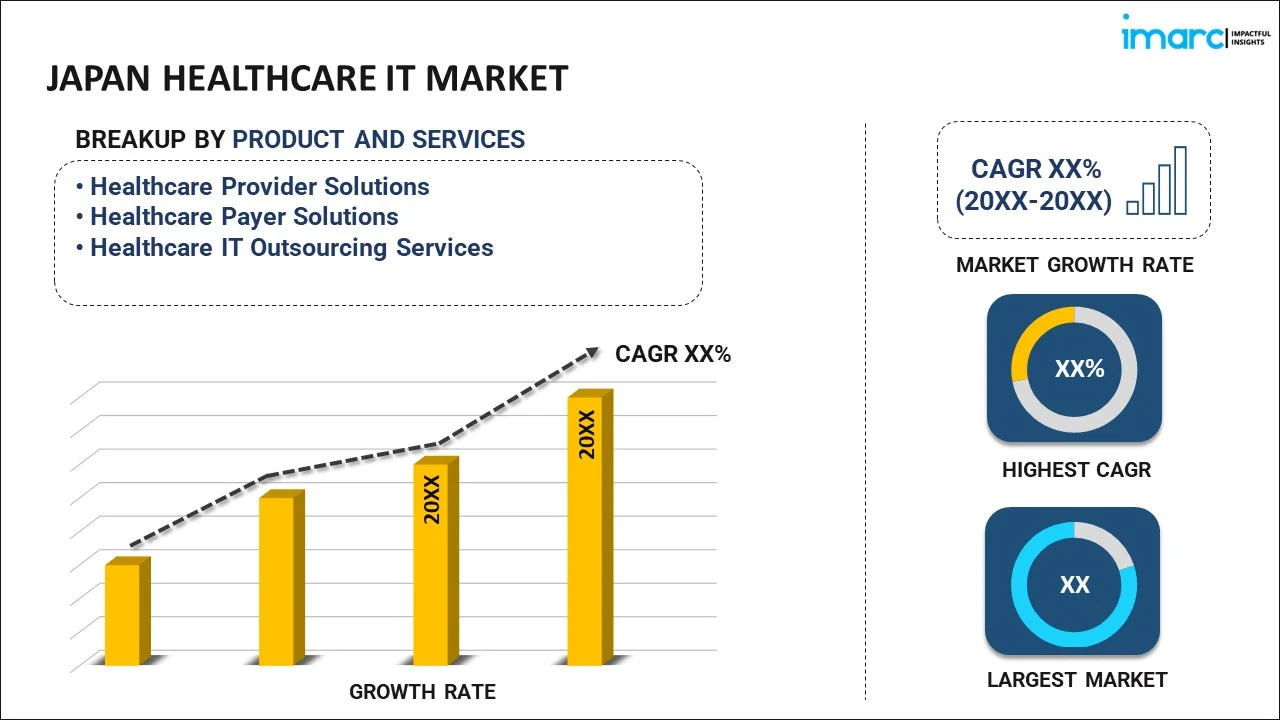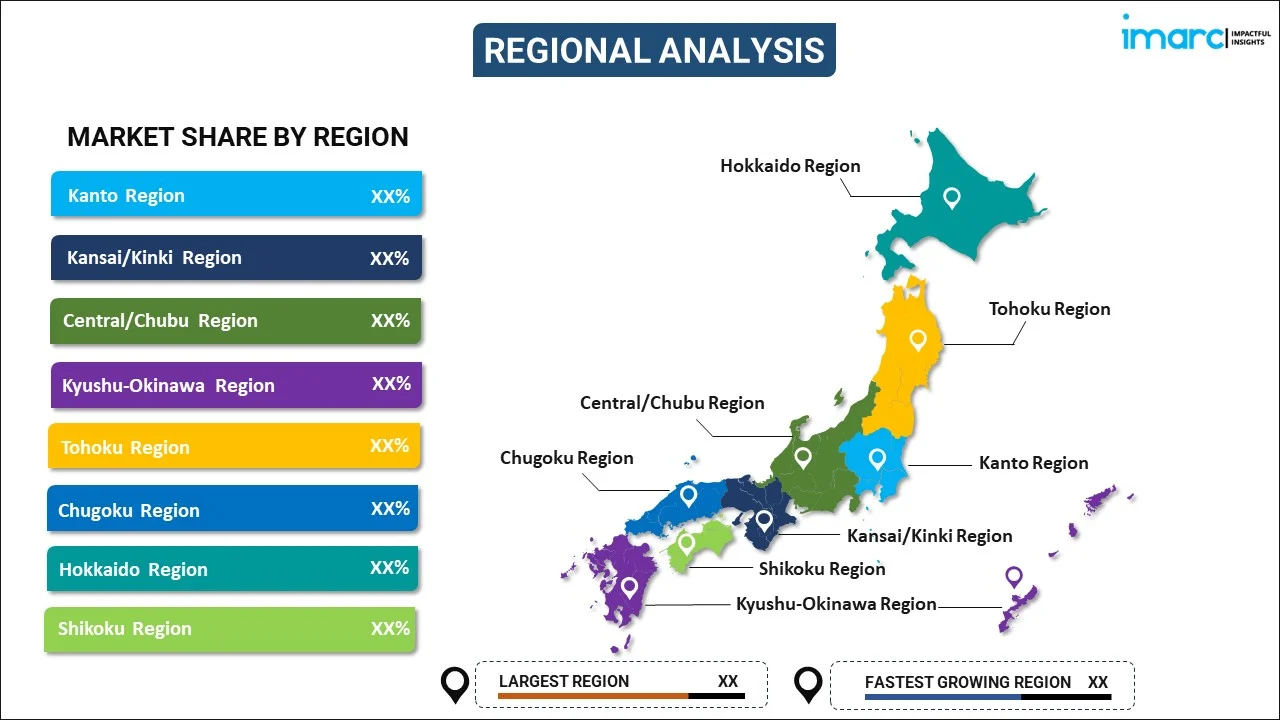
Japan Healthcare IT Market Report by Product and Service (Healthcare Provider Solutions, Healthcare Payer Solutions, Healthcare IT Outsourcing Services), Component (Software, Hardware, Services), Delivery Mode (On-Premise, Cloud-Based), End User (Healthcare Providers, Healthcare Payers, and Others), and Region 2025-2033
Market Overview:
Japan healthcare IT market size reached USD 15.6 Billion in 2024. Looking forward, IMARC Group expects the market to reach USD 36.1 Billion by 2033, exhibiting a growth rate (CAGR) of 9.03% during 2025-2033. The growing demand for healthcare services that cater to the unique needs of the geriatric population, increasing adoption of artificial intelligence (AI) and machine learning (ML) for data analysis, and rising volume of sensitive patient data represent some of the key factors driving the market.
|
Report Attribute
|
Key Statistics
|
|---|---|
|
Base Year
|
2024 |
|
Forecast Years
|
2025-2033
|
|
Historical Years
|
2019-2024
|
| Market Size in 2024 | USD 15.6 Billion |
| Market Forecast in 2033 | USD 36.1 Billion |
| Market Growth Rate (2025-2033) | 9.03% |
Healthcare information technology (IT) refers to the use of technological solutions and systems to manage, store, exchange, and analyze health information within the healthcare sector. It comprises electronic health records (EHRs), which are centralized digital repositories of patient health records. It consists of health information exchange (HIE) platforms that enable the secure sharing of patient information among healthcare providers. It includes health analytics, which are tools that analyze and interpret health data to derive meaningful insights. It also encompasses applications designed for smartphones and tablets to support health monitoring and management. Healthcare IT enhances the quality of patient care by providing healthcare professionals with timely and accurate information, leading to better-informed decisions. It helps to streamline processes and ultimately lower operational costs while improving efficiency in healthcare delivery. It enables patients to actively participate in their healthcare management through access to their health records, communication with healthcare providers. It enables healthcare professionals to analyze large datasets, identify trends, and make informed decisions to improve public health outcomes. It contributes to the early detection of disease outbreaks, helping public health authorities implement timely interventions and control the spread of diseases.
Japan Healthcare IT Market Trends:
At present, the increasing adoption of electronic health records (EHRs) to transition from traditional paper-based systems to digital platforms represents one of the crucial factors impelling the growth of the market in Japan. Besides this, the rising demand for interoperable solutions, fueled by the need for comprehensive patient data sharing among healthcare providers, ensuring continuity of care and reducing duplication of diagnostic tests, is contributing to the market growth. In addition, the growing popularity of telehealth services as they expand healthcare access to remote areas and provide a convenient alternative for routine consultations, reducing the burden on physical healthcare facilities, is offering a favorable market outlook in the country. Apart from this, the increasing adoption of artificial intelligence (AI) and machine learning (ML) for data analysis, predictive analytics, and personalized medicine are enhancing clinical decision-making, leading to more accurate and timely diagnoses. Additionally, the rising volume of sensitive patient data being stored and exchanged electronically necessitates robust security measures to protect against cyber threats and unauthorized access. Healthcare organizations are investing heavily in advanced cybersecurity solutions and compliance frameworks to safeguard patient information and maintain trust in the digital healthcare landscape. Moreover, the escalating demand for healthcare services and technologies that cater to the unique needs of older individuals is bolstering the market growth in the country.
Japan Healthcare IT Market Segmentation:
IMARC Group provides an analysis of the key trends in each segment of the market, along with forecasts at the country level for 2025-2033. Our report has categorized the market based on product and service, component, delivery mode, and end user.
Product and Service Insights:

- Healthcare Provider Solutions
- Clinical Solutions
- Nonclinical Healthcare IT Solutions
- Healthcare Payer Solutions
- Pharmacy Audit and Analysis Systems
- Claims Management Solutions
- Analytics and Fraud Management Solutions
- Member Eligibility Management Solutions
- Provider Network Management Solutions
- Billing and Accounts (Payment) Management Solutions
- Customer Relationship Management Solutions
- Population Health Management Solutions
- Others
- Healthcare IT Outsourcing Services
- Provider HCIT Outsourcing Services Market
- Payer IT Outsourcing Services
- Operational IT Outsourcing Services
The report has provided a detailed breakup and analysis of the market based on the product and service. This includes healthcare provider solutions (clinical solutions and nonclinical healthcare IT solutions), healthcare payer solutions (pharmacy audit and analysis systems, claims management solutions, analytics and fraud management solutions, member eligibility management solutions, provider network management solutions, billing and accounts (payment) management solutions, customer relationship management solutions, population health management solutions, and others), and healthcare IT outsourcing services (provider HCIT outsourcing services market, payer IT outsourcing services, and operational IT outsourcing services).
Component Insights:
- Software
- Hardware
- Services
A detailed breakup and analysis of the market based on the component have also been provided in the report. This includes software, hardware, and services.
Delivery Mode Insights:
- On-Premise
- Cloud-Based
The report has provided a detailed breakup and analysis of the market based on the delivery mode. This includes on-premise and cloud-based.
End User Insights:
- Healthcare Providers
- Hospitals
- Ambulatory Care Centers
- Home Healthcare Agencies, Nursing Homes, and Assisted Living Facilities
- Diagnostic and Imaging Centers
- Pharmacies
- Healthcare Payers
- Private Payers
- Public Payers
- Others
A detailed breakup and analysis of the market based on the end user have also been provided in the report. This includes healthcare providers (hospitals, ambulatory care centers, home healthcare agencies, nursing homes, and assisted living facilities, diagnostic and imaging centers, and pharmacies), healthcare payers (private payers and public payers), and others.
Regional Insights:

- Kanto Region
- Kansai/Kinki Region
- Central/ Chubu Region
- Kyushu-Okinawa Region
- Tohoku Region
- Chugoku Region
- Hokkaido Region
- Shikoku Region
The report has also provided a comprehensive analysis of all the major regional markets, which include Kanto Region, Kansai/Kinki Region, Central/ Chubu Region, Kyushu-Okinawa Region, Tohoku Region, Chugoku Region, Hokkaido Region, and Shikoku Region.
Competitive Landscape:
The market research report has also provided a comprehensive analysis of the competitive landscape. Competitive analysis such as market structure, key player positioning, top winning strategies, competitive dashboard, and company evaluation quadrant has been covered in the report. Also, detailed profiles of all major companies have been provided.
Japan Healthcare IT Market Report Coverage:
| Report Features | Details |
|---|---|
| Base Year of the Analysis | 2024 |
| Historical Period | 2019-2024 |
| Forecast Period | 2025-2033 |
| Units | Billion USD |
| Scope of the Report | Exploration of Historical and Forecast Trends, Industry Catalysts and Challenges, Segment-Wise Historical and Predictive Market Assessment:
|
| Product and Services Covered |
|
| Components Covered | Provider HCIT Outsourcing Services Market, Payer IT Outsourcing Services, Operational IT Outsourcing Services |
| Delivery Modes Covered | On-Premise, Cloud-Based |
| End Users Covered |
|
| Regions Covered | Kanto Region, Kansai/Kinki Region, Central/ Chubu Region, Kyushu-Okinawa Region, Tohoku Region, Chugoku Region, Hokkaido Region, Shikoku Region |
| Customization Scope | 10% Free Customization |
| Post-Sale Analyst Support | 10-12 Weeks |
| Delivery Format | PDF and Excel through Email (We can also provide the editable version of the report in PPT/Word format on special request) |
Key Questions Answered in This Report:
- How has the Japan healthcare IT market performed so far and how will it perform in the coming years?
- What has been the impact of COVID-19 on the Japan healthcare IT market?
- What is the breakup of the Japan healthcare IT market on the basis of product and service?
- What is the breakup of the Japan healthcare IT market on the basis of component?
- What is the breakup of the Japan healthcare IT market on the basis of delivery mode?
- What is the breakup of the Japan healthcare IT market on the basis of end user?
- What are the various stages in the value chain of the Japan healthcare IT market?
- What are the key driving factors and challenges in the Japan healthcare IT?
- What is the structure of the Japan healthcare IT market and who are the key players?
- What is the degree of competition in the Japan healthcare IT market?
Key Benefits for Stakeholders:
- IMARC’s industry report offers a comprehensive quantitative analysis of various market segments, historical and current market trends, market forecasts, and dynamics of the Japan healthcare IT market from 2019-2033.
- The research report provides the latest information on the market drivers, challenges, and opportunities in the Japan healthcare IT market.
- Porter's five forces analysis assist stakeholders in assessing the impact of new entrants, competitive rivalry, supplier power, buyer power, and the threat of substitution. It helps stakeholders to analyze the level of competition within the Japan healthcare IT industry and its attractiveness.
- Competitive landscape allows stakeholders to understand their competitive environment and provides an insight into the current positions of key players in the market.
Need more help?
- Speak to our experienced analysts for insights on the current market scenarios.
- Include additional segments and countries to customize the report as per your requirement.
- Gain an unparalleled competitive advantage in your domain by understanding how to utilize the report and positively impacting your operations and revenue.
- For further assistance, please connect with our analysts.
 Inquire Before Buying
Inquire Before Buying
 Speak to an Analyst
Speak to an Analyst
 Request Brochure
Request Brochure
 Request Customization
Request Customization




.webp)




.webp)












